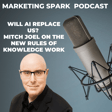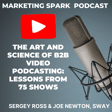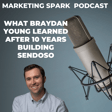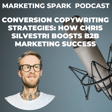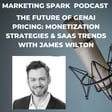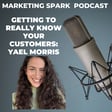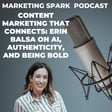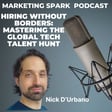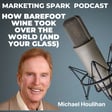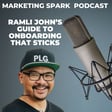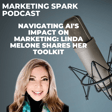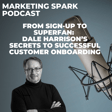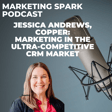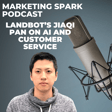Challenges of Virtual vs. In-Person Presentations
00:00:00
Speaker
listening to marketing spark the podcast that delivers insight tools and tips from marketers and entrepreneurs in the trenches in 20 minutes or less It's one thing for companies to embrace virtual events. But what about the people who need to make presentations? What's it like to talk into a camera versus being on stage and being able to engage with an audience and see how people are responding?
Introduction to Pitch Coach Andrew Churchill
00:00:23
Speaker
In this episode, I'm talking with Andrew Churchill, a pitch and presentation coach. Andrew helps people focus on better content and visual development, as well as voice, body language, and other engaging strategies. Depending on how you look at it, Andrew is facing a big business opportunity or a big business challenge. And that's what we're going to get into today. Welcome
Rise in Virtual Presentation Coaching During COVID
00:00:45
Speaker
to Marketing Spark, Andrew. Thank you. It's great to be here.
00:00:49
Speaker
Let's talk about what you do and more importantly, how your business has been impacted by COVID and the lack of in-person events. Yeah. So it's interesting with COVID. I apologize sometimes for saying this because I know it hasn't been true for everyone, but my business has actually exploded. I think the key to the explosion is that people are no longer, we've removed the,
00:01:16
Speaker
the emotional barrier to asking for help. So it used to be that people presented in person. Everybody thinks they're a good presenter. People don't really think they need help. It's kind of cool to be good at this. We all have that secret like, oh yeah, I could do a TED Talk. And what's happened when we moved online and now we're working with video cameras is everybody says, oh my God, I have no idea what's going on. Help.
Demand for Virtual Interaction and Community Building
00:01:40
Speaker
So it's opened up a whole new group of people. It's given people permission to ask for help. So what you're saying is that people who may have been comfortable speaking in person are uncomfortable speaking virtually, but they still want to present.
00:01:59
Speaker
but they want to do it in the right way. They want to do it in ways that are engaging and they're coming to you for help, which is, it's really interesting to hear that point of view that you are busy. You, a person who focuses on helping people make presentations, mostly in public, are busy during COVID. I find that fascinating. Yeah, it's been good news for me. A lot of my work is done through the university at McGill.
00:02:25
Speaker
So some of it and the
Failure of Virtual Events to Engage
00:02:26
Speaker
presentation world is still going on there. Interestingly enough, a lot of the presentation work I do there has actually increased because it's the one event that can keep going, right? So it's a way to actually, so doing virtual conferences and virtual events, virtual talks with each other is one of the places we can still create community because we can't travel.
00:02:53
Speaker
So I think the demand actually for online interaction, the demand for interaction has gone up because we're not interacting with each other, walking down the street, sitting in our offices. So we're all thirsty for interaction. And it's just a matter of trying to figure out ways to meet that need.
00:03:19
Speaker
I want to get into how people can engage their audiences virtually and drive interaction. But before we get into that, I'm really curious about your thoughts on virtual events. This has been a topic that I have been focused on, maybe you could say obsessed with recently because most virtual events that I
00:03:38
Speaker
register for and actually attend are pretty awful.
Replicating Spontaneous Interactions Online
00:03:42
Speaker
It feels like a webinar. It feels like someone is broadcasting to me versus creating an environment where it's interactive, I feel engaged, I feel like there's a sense of maybe there's spontaneity, maybe there's serendipity, the opportunity to learn and meet new people. I'm not getting that at all. And I'm just curious about what your view is on virtual events, given you've got a completely different perspective.
00:04:06
Speaker
So I'm so I have a new paradigm that actually I haven't shared with anyone yet. So this will be good. I'll be interested to see how you you react to this and see if it starts to resonate with you, Mark. And the paradigm is this. When we go to a conference, there are two things going on. One is the dissemination of information. So if we go to a conference and we sit in a we sit in a presentation for 10 minutes, 15 minutes, half an hour, however long the person was allowed to talk.
00:04:35
Speaker
That's a dissemination moment. But there's another piece of conferences, and just before we leave the dissemination moment, that actually works really well online. The online space is actually really good for disseminating information. The other piece, though, is the communal piece. And that doesn't happen when we're sitting listening to someone. That happens when we're getting a cup of coffee between talks.
00:05:04
Speaker
Or that happens when we introduce ourselves to the person next to us before a talk starts. And that space has been completely eliminated in the virtual conference world. And
Challenges of Synchronous vs. Asynchronous Interaction
00:05:16
Speaker
I don't think people have figured out how to replicate it. And I frankly am not even sure it's possible.
00:05:25
Speaker
That's an interesting perspective because to me, that's the conference goal. When I go to conferences, to be honest with you, I could easily be on stage. I don't mean that in a boastful way. It just means that the information that I'm getting from most speakers, I already know. I'm really not there for the content, although some of it can be interesting. What I'm there for is the people. I'm there for the opportunity to
00:05:48
Speaker
bump into someone unexpectedly or to meet completely new people and open up completely new opportunities that's the value for me and i think you're right i think a lot of conferences are struggling with that i look at a platform like hop in, which allows people to hold these it's almost like speed dating so you're on a virtual event and then they'll have the speed dating opportunity will meet somebody random in a in a side room which i think,
00:06:12
Speaker
tries to replicate that conference experience, but you're right. I just don't know if anyone's going to figure it out, going to be able to replicate that whole conference experience. I, my question is that fundamentally I have a, I have a question about whether or not, so, so a lot of talks going on about synchronous versus asynchronous, right? And I think it's really difficult to do synchronous multi-people conversations
00:06:41
Speaker
online, virtually. There's a fundamental barrier of technology that people haven't really figured out yet of how do we have, like there's a reason we're doing a podcast with two people, not seven, right? Can't do it with seven people. But if we were in person, we could. And this is a real challenge. I think one of the things that conferences need to figure out is how do they create space for people to interact organically
00:07:09
Speaker
And then how do they create space for to disseminate information? And I think what's happening with conferences right now is they're just hyper focused on the dissemination of information and they're getting that fine.
LinkedIn for Asynchronous Interaction
00:07:23
Speaker
But without the organic interaction, it's useless. Nobody wants to go. It's a horrible experience.
00:07:30
Speaker
So what we need to do is figure out how to do this organic interaction. And I'm not sure, you know, to me, my best organic interaction in the last six months has been in the last 60 days and it's all been on LinkedIn and it's all been asynchronous. But you and I have, you and I have had conversations on LinkedIn and sometimes there's four hours, sometimes there's three days between those responses.
00:07:59
Speaker
but we've gotten to know each other. We've developed a relationship. We've gotten to know each other's businesses. We've now ended up having a conversation virtually with the two of us in the form of this podcast. But I do think that there's some asynchronous components that virtual conferences ought to be looking at and integrating things like volley that's coming out with like a, um, and, and LinkedIn just started, right? Where now you can send people a short, a short audio clip. What do you think?
Enhancing Audience Engagement Virtually
00:08:30
Speaker
It's a new landscape. It's a completely new engagement landscape. And we're all trying to figure it out. And I think that's one of the interesting things about LinkedIn that is happening right now. People are making connections. They're commenting. There's all that activity going on. And I still believe that the real value to LinkedIn is conversations, is the ability to break through the digital barrier and ask someone if they're open to having a conversation. And my experience has been, for the most part,
00:08:58
Speaker
that you're right. As you said earlier, people are thirsty for interaction. They're thirsty for conversations. They're thirsty to connect with other people. And so those barriers have totally disappeared. And I'm talking to people all around the world and the conversations, people are enthusiastic. They're interested. They're curious. And this is something that I don't think would have happened pre-COVID.
00:09:20
Speaker
Now let's turn our are set a little bit to what you do and how you are helping people do a better job presenting virtually so when i do presentations like i'm a very. Energetic speaker and i move around the audience and i ask questions and people that's part of my stick right but.
00:09:40
Speaker
How do people engage audiences digitally when you're just looking at their face? What are some of the techniques that they can use to get their audience excited, curious, interested, all the good things that happen when you present in person? So this is another one where I'm coming up a little against a paradigm wall here. And I'm starting to think about this word engagement. And what does it actually mean? Because traditionally engagement has been about
00:10:11
Speaker
speaker-audience interaction, right? So there's some things you can do. There's some really good tools for increasing that online. Some of the things I do, like I will use polls quite a bit, because it's really easy to get everybody in the audience to answer a poll. And I don't ask trick questions, but I ask questions. I tend to ask questions that every answer is correct. And then I ask someone who gave, you know, I ask someone who said C, which,
00:10:40
Speaker
maybe only 10% of the people answered C, I say, okay, someone who said C, will you tell us why you said that? Because I think that's really smart and it would be great if everyone could hear from you. And I always get someone who pipes in in those situations. So I haven't called on someone specifically, but I have gotten some audience interaction that is more curated. So I think the key to audience interaction
00:11:08
Speaker
when you're in the online spaces to curate it. In other words, you've got to set it up more than when you're in person. Some of the other things you can do, so I do simultaneous responses to a chat question. If you've never done that, it's super interesting. What you do is you ask a chat question and then you give the audience 30 seconds to type in their answer and then everybody hits enter at the same time.
00:11:37
Speaker
And there's this weird, everybody feels like they need to do it. So people actually do it. Like I get response rates upwards of 90% when I do this. And then suddenly as a speaker, you have this incredibly rich, say you have 20 people, 30 people, you have 20 or 30 comments, you can then build the next 10 minutes of your presentation responding to the ones that you want to. So those are two tricks in the,
00:12:06
Speaker
traditional engagement space. But I said I was running into a little bit of a paradigm shift here. And the paradigm shift here is that what happens if engagement isn't really audience? What happens if we made an engagement not about speaker audience, but about audience content?
Conducting Group Work in Virtual Settings
00:12:32
Speaker
Which is really what we want
00:12:35
Speaker
to engage our audience with, right? We want to engage our audience with the content, not with us. And that shift to me, so I started just thinking about this question, I was actually thinking about it this morning, because you had asked me this question a couple of days ago, right, as we were getting ready, and I was giving this some thought. And in that case, so if I want people to better engage with the content, then I fall back to stories. Because stories engage people. And I fall back to really powerful visuals.
00:13:05
Speaker
Like you show someone a really powerful visual that triggers an emotional response. And that engages the person. But those are two different ways to think about engagement, I think.
00:13:20
Speaker
Okay. I've got a bunch of follow-up questions. One would be, of course, one would be, okay. From a technical perspective, like you mentioned earlier that you would give people options, A, B, or C, and the person who you would ask someone who answered C to respond. So does that mean that you've got, they can, there's an open mic. They have the ability to pipe up when they want verbally, or do you have to open up a different channel when you want that to happen?
00:13:48
Speaker
Most of my work I do with open mics or I do with a, I can give them permission. So somebody can raise their hand and then I can unmute their mic.
00:14:01
Speaker
The other question that I had when you talked about the 30 second go and do your own thing technique, how do you feel about silence? And the reason I ask is that when I've done workshops, what I do is I'll give some, I'll give people an exercise and I'll say, okay, spend the next five minutes working on this exercise and then we'll have a group, you'll present and then we'll have a group discussion. And people love that. They love the ability to do their own work or work with a small group and then
00:14:31
Speaker
present and learn from other techniques and get other approaches and get that feedback from other people in the room. Now, is it possible? Does it make sense to do that online? So let's say that we're doing a presentation and we have a little worksheet that we want someone to fill out. Can we say, okay, for the next five minutes, do your own thing and then we'll circle back. Does that work at all? I do it all the time. I do it. Really? So I use Zoom as kind of the go-to.
00:15:01
Speaker
because that's what McGill uses. And they have breakout rooms. So I send people with an exercise to do with each other in a breakout room. I think Zoom works really well with groups of five and less. So that's kind of my cap on rooms is I put people in rooms of five and they work. And when I do do individual exercises, I actually put everybody in their own breakout room.
00:15:31
Speaker
because it's kind of weird being on Zoom when everybody's quiet. But if you send everybody to their own breakout room, then the feedback I've gotten from people is less, it's less weird because then they're in a room by themselves working quietly and it's not like, oh yeah, people can see me now or people can hear me if I mistakenly put my mic on or people, it's kind of this, oh yeah, now I can go work and then I can come back.
00:16:02
Speaker
and there's that moment of coming back because you shut down the breakout room and everybody comes in altogether. The other thing that is interesting, I think working online is working with stuff like Google Docs or OneDrive where you have a shared document and everybody can be working on the same document at the same time or different parts of the same document at the same time. And then you can combine the two where you send people to a breakout room, they work in their breakout room
00:16:29
Speaker
on a document that's shared with the other breakout rooms.
Importance of Content Quality and Presenter Skills
00:16:33
Speaker
So you can have a conversation of four or five people going on about a shared document that 40 people are working on. Yeah, because I mean, if you have a common template and everyone's filling it out, then that would work. But you're suggesting that it would only work in small groups as opposed to having 50 people completing an exercise on Zoom. 50 people can be completing an exercise, but 50 people can't be in the same room talking about it.
00:16:59
Speaker
One more question I wanted to ask you about this whole concept of engagement is that how do you keep people on point when they're at home and it's easy to be multitasking, checking their email, surfing the web, doing work, all the things that they probably shouldn't do because the reason they're at a virtual event is to attend the virtual event. Are there any tools, techniques, anything that you can do to make sure that people don't do that or is that come down to the quality of the content?
Tips for Effective Virtual Delivery
00:17:28
Speaker
think it comes down to the quality of the content and the quality of the presenter. And there's one trick you can do. There's a little bit of an online shift with the quality of the presenter. The quality of the presenter online
00:17:43
Speaker
is all about voice. There's so little video with most of the presentations because most of the presentation work, there's a visual support, right? So you're looking at something like PowerPoint. It's different if you're doing a TED Talk where the primary visual is the person. But as soon as the primary person is the visual being shared, not the person, then it's all about voice. And the biggest mistake people make presenting online is they're sitting in their chair at their desk and it's just a disaster.
00:18:14
Speaker
It's like you'd never be sitting in a chair giving a talk. Why are you sitting in a chair when you're presenting? It's stupid. So what should I do instead? Stand up. I'm standing right now. Our voice is better when we're standing and when we're gesturing. So even though I'm not on camera, I'm still gesturing. I'm walking around, I'm standing up. I like to have two different, I have two different places because I do a lot of presenting because all my teaching is online and all my teaching is presenting or workshops.
00:18:43
Speaker
So I actually have one corner of the room where I have a bureau that's like one of those six drawer bureau. So it's really high. It's chest height. I have a set up there for presenting with a green screen. It doesn't take up hardly any room because the green screen is only a foot behind me and I'm standing right next to the bureau. And then on the other side of the room, I have my desk. I work for my desk, but when I go to present,
00:19:09
Speaker
I go stand up and I'm in a different place and psychologically it's like going to work, right? If you were going to a conference to present or if you were going to an auditorium to present, you'd enter the auditorium. I have a little hole in the green screen at the end and I enter the presentation space. So I have that mental switch that people aren't doing because they're sitting at their desk presenting from their desk.
00:19:35
Speaker
Yeah, I love the idea of gesturing by yourself in a room because it feels like, I don't know, it feels like, I don't know, singing at the top of your lungs in the shower, right? Cause you feel like you're performing, but no one can, no one can see you. So it seems kind of weird, but I guess in time you get used to it. And if you think about the virtual reality space, which is kind of what we're playing in, right? There's this, there's the concept of immersion that happens, right?
00:19:59
Speaker
That's what you need to do for your audience. You need to do the immersion piece for your audience so your audience feels like they're there in the room with you even though it's on screen. And that comes from voice, it comes from gestures, it comes from all the same things that happen. So the people who are good at presenting in person are good at presenting online as long as they do what they would be doing in person, right?
00:20:28
Speaker
So I say channel that in-person presenter, even though there's no one there.
Avoiding Common Virtual Presentation Mistakes
00:20:32
Speaker
And it feels a little silly. Like you're like, I'm like gesturing at my wall. Okay. One final question, and this is probably a loaded question is what are some of the mistakes that speakers make virtually and how can people prepare themselves properly before they make a virtual presentation? So one is to stand up. Sitting, sitting down is a big mistake.
00:21:00
Speaker
There's another inline in-person shift that's a technical one, and that is thinking that our PowerPoint or our visuals that we're sharing are doing the same thing in the two spaces, and they're not. They're very different. So there's some science to suggest we only look at a still image for somewhere between seven and 15 seconds before we move on.
00:21:28
Speaker
So if you're talking about keeping people on the image you're sharing rather than going to their email, right, which is also on their computer screen, that image needs to evolve every seven to 10 seconds. There needs to be some sort of visual movement. It doesn't need to be much, but it needs to be a little bit.
00:21:49
Speaker
So right. So we do this exercise. I do this exercise with people called activate your PowerPoint if you're working in PowerPoint or whatever visual you're working in. And it's just simply making it active. So you animate it. So. So in one idea comes in at a time instead of all the ideas coming in. You use more things so that if you have four or five ideas, the idea that you're talking about gets bigger.
00:22:16
Speaker
and you talk about it and then it gets smaller and then the next one gets bigger. In person, you don't want to do this because in person, if your PowerPoint slides like our little lizard brain, right, when we're in person and there's movement in our peripheral vision, we want to look at it. So when our PowerPoint's active and we're in person, people aren't looking at the presenter, they're constantly being distracted by the slide. But online, you're not really there, you're really just there vocally.
00:22:46
Speaker
And there's good research that's actually pretty old because it's about online courses. And if you've taken some online courses, you notice that the presenter's there in the beginning and then the presenter disappears and only comes back every once in a while. And it's because when people did the eye tracking of what people were looking at with online courses,
00:23:07
Speaker
They weren't looking at the presenter after the first minute or so. They were looking at the material being presented. And the same thing if you look at online courses and the way those visuals are developed, those are very active PowerPoints or whatever else is being delivered, but subtly so. Not like crazy things flying in and flying out. We're not trying to make it obnoxious.
00:23:33
Speaker
to take care of the little lizard brain that needs to see movement or needs to not be stuck on stillness.
00:23:41
Speaker
Well, Andrew, this has been great insight. And to be honest with you, I feel like I got a free consulting session on how to be a better, better virtual speaker.
Wrap-up and Contact Info for Andrew Churchill
00:23:48
Speaker
I do a lot of it these days and you're right. There is, there is a difference between doing it in person and virtually. And I have tried some different approaches, but some of the things you said, particularly around standing up and changing your slides on a regular basis really resonated. And I think that's great advice for
00:24:06
Speaker
anybody who is virtually doing virtual presentations or thinking about it. So where can people find out about you and learn more about what you do and, and how do you work with people that are looking to improve their presentation skills, both in person and virtually? Um, so the easiest place to find my presence is on LinkedIn. That's kind of where I, where my owner business profile has become. So, so work, work beyond McGill.
00:24:37
Speaker
Um, I have a, I have a, uh, business that I've started. It's called home communications. So home communications.ca is the, is the website, but I'm, and I have a blog there, but the, but the LinkedIn activity is, is, um, more active than the web blog. And then I, I have some YouTube, I have a YouTube channel. That's also home communications where some of this, some of the things that we've been talking about are on there. And every once in a while I do like, uh,
00:25:07
Speaker
you know, I have a two minute tutorial on like activating your PowerPoint and that's on, and I'll post those on YouTube.
00:25:16
Speaker
Thanks for listening to another episode of Marketing Spark. If you enjoyed the conversation, leave a review and subscribe via iTunes or your favorite podcast app. For show notes of today's conversation and information about Andrew, visit marketingspark.co slash blog. Now, if you have questions, feedback, would like to suggest a guest or want to learn more about how I help B2B companies as a fractional CMO consultant and advisor, send an email to mark at marketingspark.co. I'll talk to you next time.



